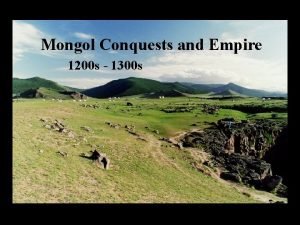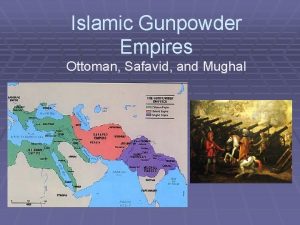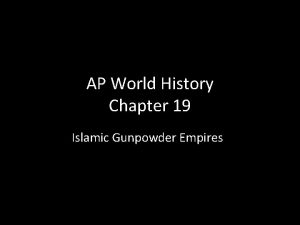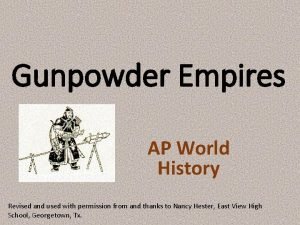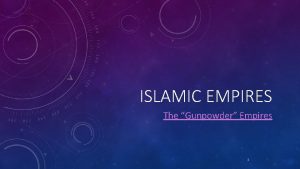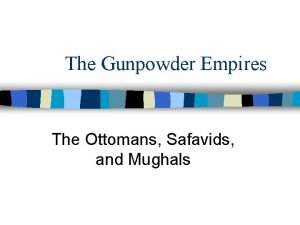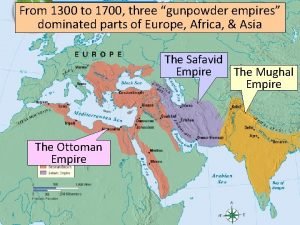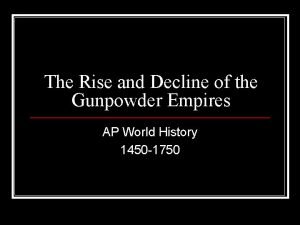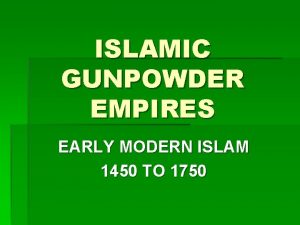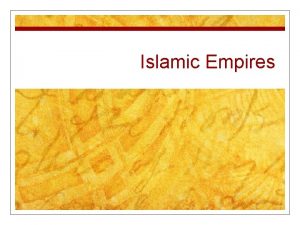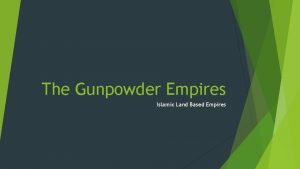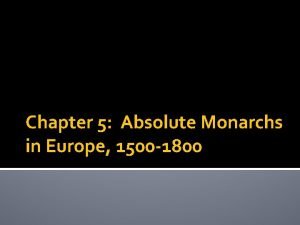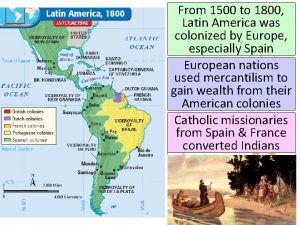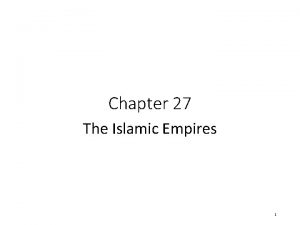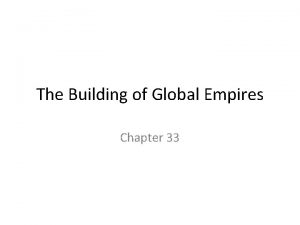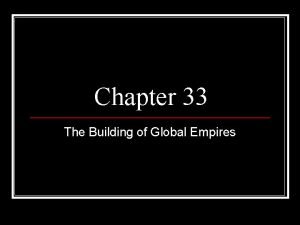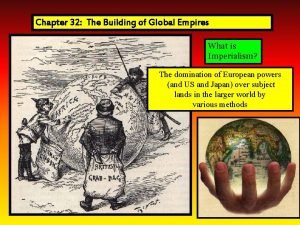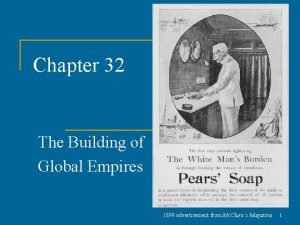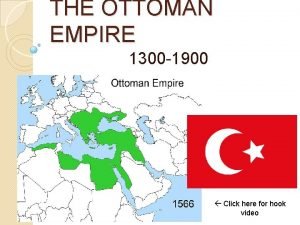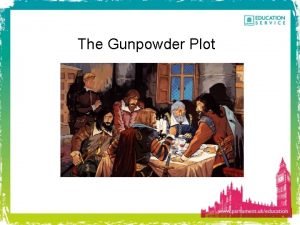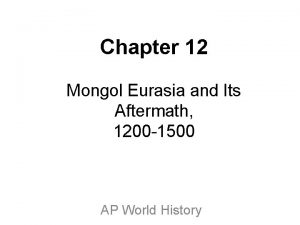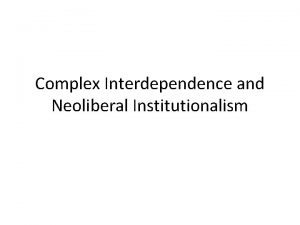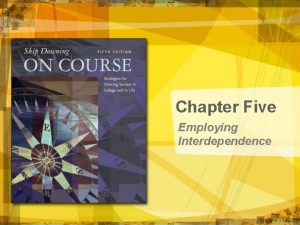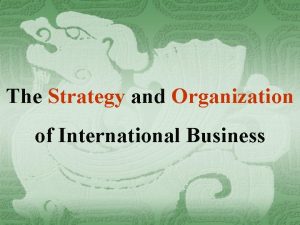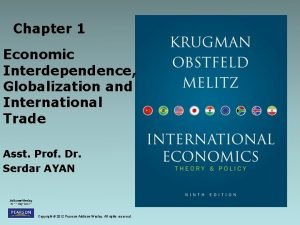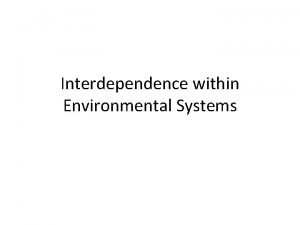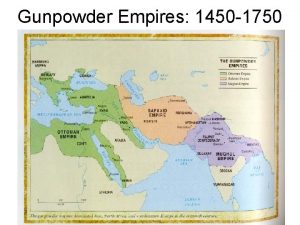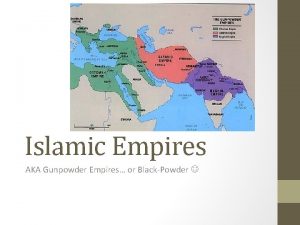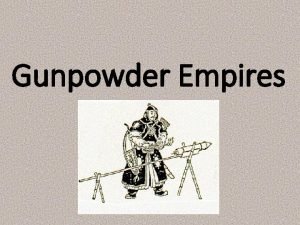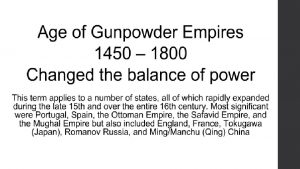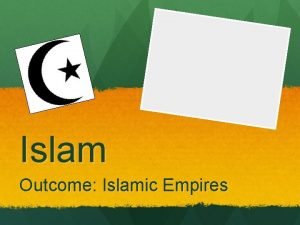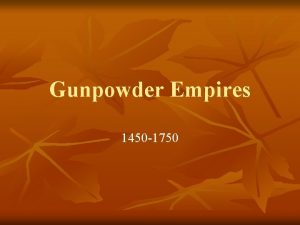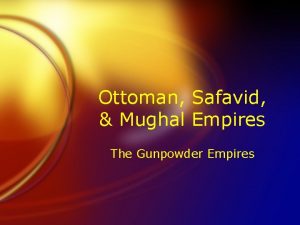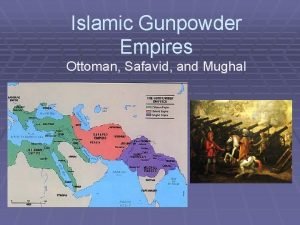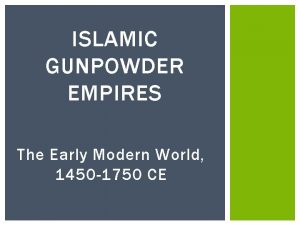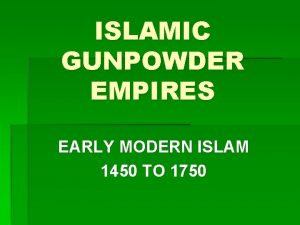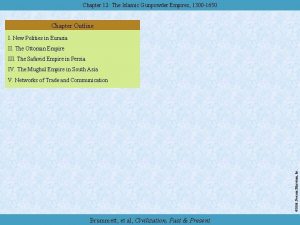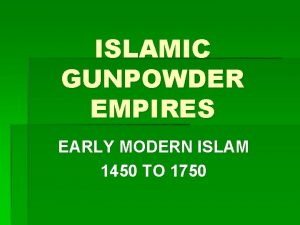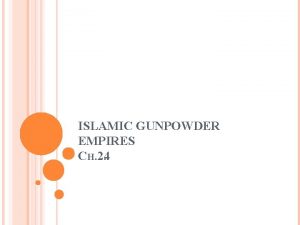The Islamic Gunpowder Empires 1500 1800 Global Interdependence

The Islamic Gunpowder Empires 1500 -1800 Global Interdependence and Exchange

Trio of Empires n n n Ottoman Empire (1289 -1918) Safavid Empire (15011722) Mughal Empire (1523 -1739)

Islam n n Central to nation-state expansion Religion, culture & civilization Quran – Holy book. Revelations given to Mohammed. Sharia – Totality of political, religious, social and private life.

5 Pillars of Islam n n n Declaration of Islam Prayer Fasting – Ramadan Almsgiving – Zakat Pilgrimage - Hajj

Islam is not monolithic n n n Sunni – Approximately 90% of Muslims. Shi’a – Re-established with the emergence of the Safavid dynasty. Sufi – Mystic tradition.

Ottoman Empire 1298 -1918 n n First of the three Reached its peak in 1600 Survived through WWI Present day Turkey

Ottoman – Beginnings n n n Grew from remnants of Turkic peoples after fall of Mongol Rule Ghazi Warriors Osman Bey

Empire Building 1300 -1400 n n Janissaries (yeni cheri) Greece, Albania, Bulgaria and former Yugoslavia Official recognition of Orthodox Christian Church Invasion of Timur destroyed most of empire

Mehmed the Conqueror 1451 -81 n n n Taking of Constantinople “Sovereign of the Two Lands and the Two Seas” – Established Ottoman Empire in Europe and Asia Artillery & naval power

Military Campaigns 1480 -1520 n n n Shift focus from Christian Europe to Islamic Empires in Egypt and Persia Fierce campaign against the Safavids Mecca and Medina

Suleyman I 1520 -66 n n Suleyman the Magnificent Height of the Ottoman Empire Further move into Europe Renewed hostilities with Safavids

Franco-Ottoman Alliance 1536 n n n Holy Roman Empire vs France Ottomans sided with France Cornerstone of European diplomacy Countered other European alliances Suleyman able to focus on conquest of other Islamic Empires

Relations with Safavids n n Renewed hostilities Took Baghdad and Tabriz, the capital By 1538 controlled Persian Gulf and Red Sea Treaty of 1555 returned Tabriz to Safavids

Death and Decline n n Loss to Europeans at Malta - 1565 Suleyman died in 1566 By 1600 lost much of its power Survived until the end of WWI

Safavid Empire 1501 -1722 n n Origins as a religious sect Officially a Shi’ite empire Short lived Present day Iran

Shah Ismail 1501 -26 n n Twelver Shi’ism official religion Violent conversion Qizilbash Claimed Ottoman land

Instability 1524 -87 n n n Death of Ismail – 1524 Power struggle among Qizilbash Move to more secular administration Attempt to return to Sunni origins Number of rulers unable to stabilize empire

Abbas the Great 1587 -1629 n n Rejuvenated empire Quelled internal revolts Faced Ottomans Enhanced trade with Europeans

Domestic Affairs n n n Permanent paid army to counter Qizilbash infighting Centralization of power Relocation of capital to Isfahan

Conflict with the Ottomans n n Peace Treaty of 1590 Retook Tabriz in 1605 Recaptured Baghdad 1623 By death in 1629 Safavid Empire restored to borders established by Ismail I

Europeans n n Concluded new trade agreements to offset losses to Portuguese Traded Persian silks with English Became middleman for Indian goods Allied with British against Ottomans

Decline n n Abbas I feared ascension to throne Ceased giving provincial governorships to Safavid princes No shah was prepared to hold empire together Fell to Afghan invaders

Mughal Empire 1523 -1739 n n n Struggle to consolidate Succession of strong rulers Eventually absorbed by British Empire in India – mid 19 th century

Founding of the empire n n n Previous examples of positive Muslim. Hindu relations Babur established capital at Kabul (present capital of Afghanistan) Consolidated territory of Hindustan (India) with use of artillery

Humayun 1530 -56 n n Unstable administration Brothers challenged for the throne Race for territory with Sher Shah Held onto Mughal Empire

Akbar 1556 -1605 n n n Consolidated and expanded empire Put down challenges to the throne Continued tradition of tolerance of Hindu traditions

Conquest and Expansion n n Rajasthan Province of Bengal Hindustan Plain Province of Kashmir

Religion & Administration n Tolerated Hindu religion Invited missionaries to teach tenets of Christianity Moved away from orthodox Islam

Transition n Campaign for the southern tip of the Indian subcontinent Strained relations between Hindus and Muslims Social unrest

Imperial Islamic Society n n n Military Nation-State Economics Islam & Art

Military Nation-State n n n Empires legitimized rule with military conquest Armies were important part of leadership Use of gunpowder artillery turned tables of warfare

Economics n n n Trade – extensive routes Agriculture and commerce Point of exchange

Islam & Art n n n Architecture Poetry Painting

Decline of Islamic Empires n n n Limits of military state Economic stagnation Cultural islands

Limits of Military State n n n Inconsistent leadership Costly wars of conquest Internal dissention and competition

Economic Stagnation n Weak middle-class Trade routes began to move onto the sea routes Loss of revenue with loss of territory

Cultural Isolation n European interest was not reciprocated Resistance to outside cultural influences Faith and tradition vs. technology

Conclusion n n Empires represented growing interdependence Exchange of people, ideas and technology Use of artillery changed warfare Legacy of art, religion and nation
- Slides: 38
